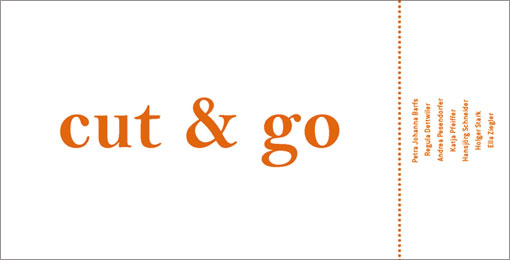
"Cut & go" – this sounds short and sweet, quick and easy. Materials are separated, divided and cut. At first glance simple, straightforward, even banal.
However, in utilising a wide variety of materials and techniques in the artistic process, those seemingly simple procedures of separating, dividing and cutting open a vast range of possibilities.
How do artists deal with the newly emerging hybrid material? What about the gaps and fractures that open up? What happens at the intersections? And will the cut-out parts be further combined, assembled and transformed, or will they become remnants, or perhaps even waste? Is the blank space problematic, or is it precisely within those gaps where the actual work forms?
The exhibition „cut & go“ brings together sculpture, mixed media, works on paper, performance and installation, all of which feature the techniques of separating, dividing and cutting in a wider sense.
The exhibition focuses in on the different attitudes and approaches adopted by each artist, and how they interrogate such processes. It is not limited to formal concerns, however, since these techniques open the possibility for a political or social-critical reading of the work. Each cut, fracture or gap appears not only on a material level, but raises questions surrounding individual and social pasts and futures.


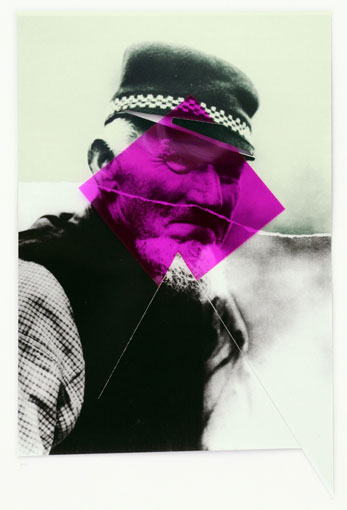
The starting material for my collages are high-quality coffee-table books, prints and maps which I obtain from antiquarian bookshops, antique markets or in archives. For me, direct access to the book or illustration is essential – I have to feel and see the paper before I can decide whether to use the representation or not – so I seek material across a range of book printing eras. My main focus is the presentation of landscape, of nature and its human inhabitants. In my process the reorganised material merges with the personal question on how the past comes to bear on the present.
For my work, it is important to display the found material initially in an unmodified way, then to tear through it very precisely, and finally to complement the fragment at hand with a photocopy of itself. I believe the resulting collage to be the most radical form of reflection on the li
www.petrabarfs.de
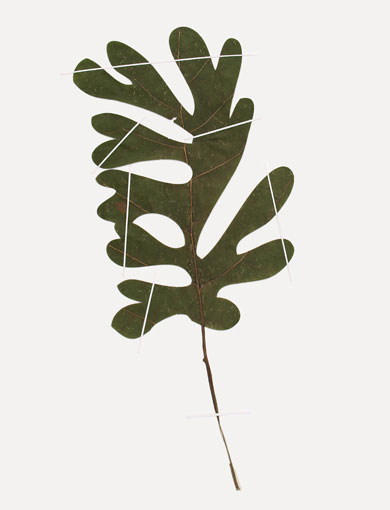
Regula Dettwiler uses different artistic methods to trace strategies and representations of naturalized artificiality. When she trims leaves of exotic pot plants with lace borders, portraits develop that are an expression of our own sensitivities and needs. Her pressed and dried plant leaves are manipulated in such a way that they, like Rorschach images, refer to a psychological dimension, and present “nature as a projection surface for human longing and fear.” Dettwiler transfers an alleged “nature” into art through reversing the procedures of abstraction found in classical modernism, such as in her series ‘Herbarium No. 1 – Drawn from Matisse,’ which takes the form of laser-cut leaves that present art as an objet trouvé from nature. (Andrea Jahn from: NACH DER NATUR, Stadtgalerie Saarbrücken, 2014)
www.reguladettwiler.com
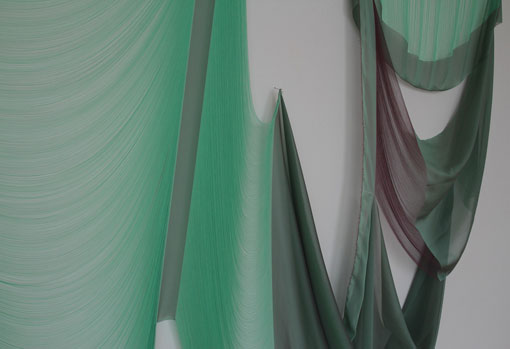
Painting through the drawing of threads – images in motion
“This strand of my artistic work originates from a discussion regarding the essential elements of painting. In my early works it was the image carrier, the canvas, which I transformed into the image itself. By drawing out or rearranging the thread lines, a number of new transparencies, gaps, vistas and shifts appeared. I was interested in what lies behind: the background, the exposed, the negative growth.
This principle is developed further in my ‘images in motion.’ The canvas has evolved into an iridescent fabric, and has escaped its frame. The threads hang loosely and are affected by the air circulation in the room, the ambient temperature, and even by visitors passing by. The pictures, therefore, have a very particular presence, becoming things in themselves, even sculptural, in a classical sense. Through the withdrawing of existing material a new con(figure)ation emerges.”
www.andreapesendorfer.at
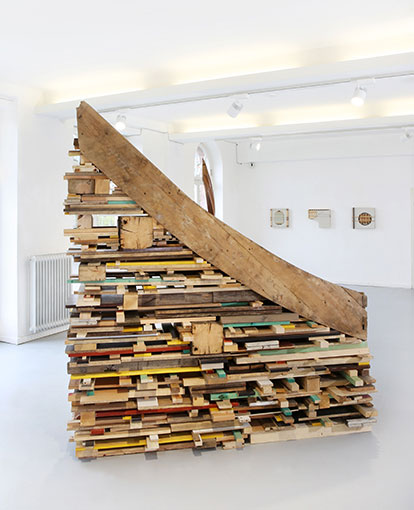
Katja Pfeiffer’s works deal with the question how humans build their surroundings. Alluding to real architecture, her quirky and fragile-seeming constructs question the notion of a methodically organised composition of the world.
Pfeiffer’s latest works appear as makeshift fortifications of modern ruins, which are the result of exploratory walks through the Italian city of L’Aquila. After the earthquake of 2009, the badly damaged buildings in the city centre were provisionally propped up to prevent further damage, a temporary solution that is still in place today.
These bizarre-looking constructions inspired Pfeiffer to produce reliefs and installations, which put the artistic focus on L’Aquila’s patchwork constructions. The installation, ‘Stairs’ is an ideal example of the fragmentary: a thrown-out landing rests on a precariously looking substructure built from stacked wooden beams and slats. Deprived of their ordinary function the old landing becomes a sculpture; its steps lead to nowhere. (Barbara Martin)
www.katjapfeiffer.com

Cutting and tearing play a significant role in the series ‘Global Ground,’ in which the artist initially cuts into the thick cardboard and then tears away parts of the paper surface. The contrast between the plain and the rough, fuzzy textures, creates a relief that resembles a landscape. Rubbing dry pigments into the paper gives the impression of water, land or raw earth.
The motifs represent details of urban infrastructure in global capitals. However, they differ fundamentally from the medial satellite images which they are originally based on, in that they give each landscapes its strangeness and material quality back. As much as these images reflect on existing locations, they appear to be somewhat unreal, fictional and subjective. They cast a subtle doubt shaking the belief in a complete and readily available collection of reality.
www.hansjoerg-schneider.de
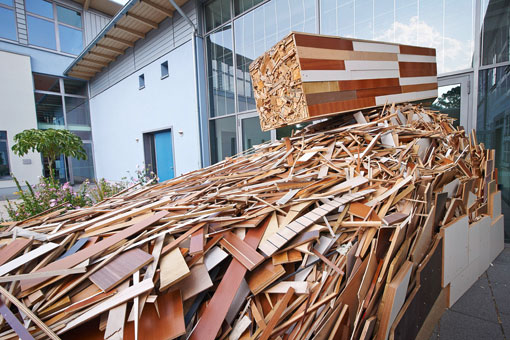
Even though he does not see himself as a classic photographer or sculptor, Holger Stark’s main working methods employ both installation and photography. He has said, “I do not search, I find,” suggesting that the act of selecting is the main modus operandi employed. Stark also utilises spatial and historical references in his installations and interventions, as a means to contextualise the chosen space and its history. Conceived and built on-site, he places and realizes his mostly wooden installations in a precise, balanced and sensitive way. The artwork divides and structures the surrounding space, both cutting through it and merging with it, tackling the space both physically and conceptually. Stark will develop a new installation for the exhibition at Künstlerhaus Dortmund, which was built in 1924 as a pithead bath and company building for Schacht Westfalia.
www.holger-stark.com
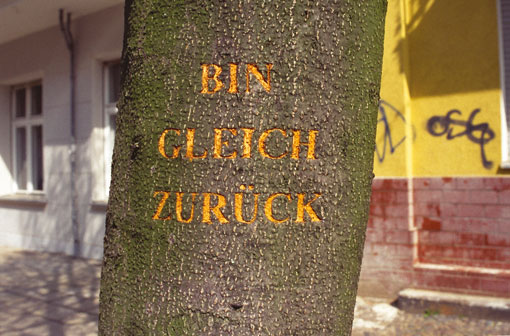
Ella Ziegler does not have a studio. Her sites of production could variously be the street, a police station, a traffic island or, indeed, our imagination. Perception, observation and interrogation of the minor details and easily overlooked aspects of her own life form the basis of her artistic works, which take the form of diary-like interventions into public space. For Ziegler, such moments are the central node in a network of relationships of cause and effect, public and private, collectivity and individuality.
Ziegler sees the public space as a form of sculpture, which she uses in her work through interventions – or invasions. Thus producing works which are difficult to grasp in either a temporal or spatial sense. Each of her works is part of an ongoing practice that is more than a concept and more than a process. Into existing visible constellations, Ziegler injects her own narrative episodes, producing and collecting pieces of evidence to prove that the boundaries between the probable and the fantastic can be crossed anytime. A selective exchange ultimately takes place between the intervention as it is, and its reversal: a play with the potentials of the utopian.
www.ella-ziegler.de